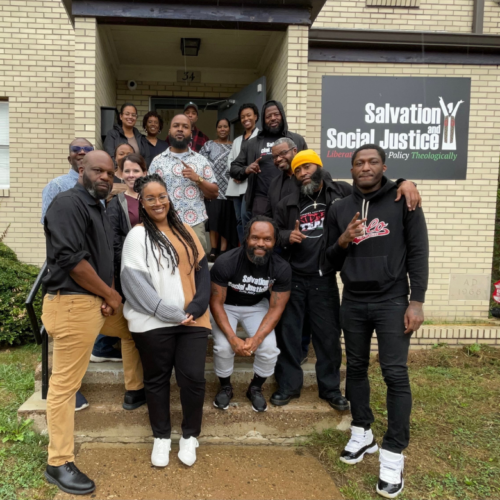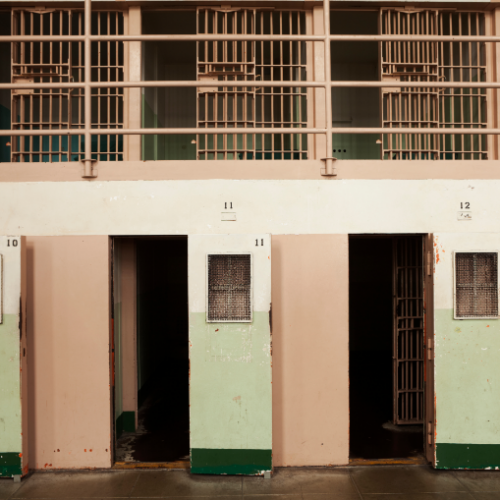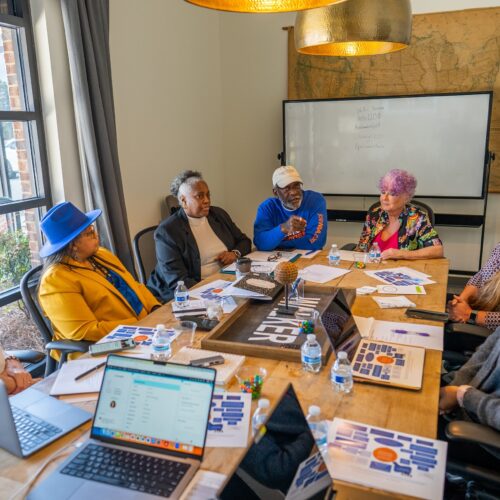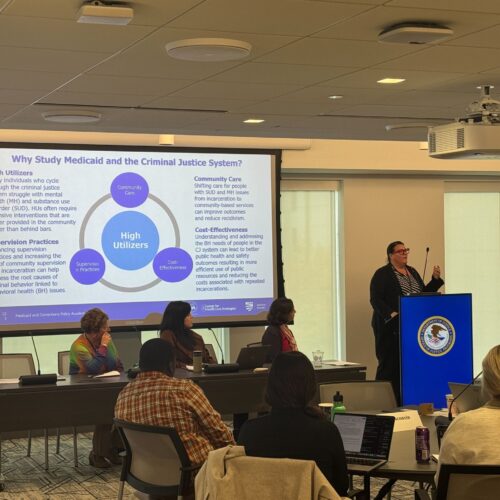As many as 100,000 youth under the age of 18 are released from juvenile correctional facilities every year. These young people often return to their communities with complex needs, such as physical and behavioral health issues and barriers to education and employment.
The National Reentry Resource Center’s Advisory Committee on Juvenile Justice is developing resources for the field to increase the likelihood of successful juvenile reentry and promote safer communities. The Committee’s work is currently focused on five key areas emerging in youth reentry policy and practice:
- Integrating the science of adolescent brain development into the design of reentry initiatives.
- Ensuring that reentry initiatives build on youths’ strengths and assets to promote pro-social development.
- Engaging families and community members in a meaningful manner throughout the reentry process.
- Prioritizing education and employment as essential elements of a reentry plan.
- Providing a stable, well-supported transition to adulthood that helps to create lifelong connections.
Integrate the science of adolescent brain development in the design of reentry initiatives.
Research conducted in recent decades has documented both the various pathways that youth follow into juvenile delinquency and the intersection of those pathways with the development of the adolescent brain. The brain is not fully developed during adolescence and into the mid-twenties, leaving youth particularly susceptible to spontaneous and less-reasoned decision-making, as well as the powerful impact of peer pressure. Effective reentry planning and case management considers these types of developmental factors that research has shown are associated with this age population.
These findings have strong implications for reentry planning, case management, and supervision strategies. Reentry planning should be grounded in cognitive approaches (e.g., cognitive behavioral therapy) that are responsive to adolescent brain development. Furthermore, cognitive approaches should be applied through an “ecological model” that contemplates the role of the youth’s family, peer group, school and community in dealing with his or her individual issues.
Case workers and supervision officers should be prepared to
- Engage the youth’s family as a key partner in supporting the youth’s behavioral change and cognitive thought processes.
- Work with youth to strengthen their relationships with pro-social peers, thereby reducing the negative peer influences to which many adolescents are susceptible.
- Support the youth’s connections to school and/or work, increasing the probability that they will be influenced by the pro-social developmental opportunities provided in the school or work setting.
While this body of knowledge comes from complex research, its implications are simple and straightforward and must be part of our work in support of the return of young people from out-of-home placement to the community.
For more information about designing reentry programs with adolescent development in mind, watch this video from the 2011 Second Chance Conference session, “Juvenile Reentry in the Context of Adolescent Brain Development and Pro-Social Connections: Using a Strength-Based Approach.”
Build on youths’ strengths and assets to promote pro-social development
While the youth with whom we work are both challenged and challenging, they also possess strengths upon which we can build. Approaching youth from a strength-based perspective means identifying and celebrating their assets and helping to enhance their positive qualities. Professionals working with youth in the juvenile justice system should encourage these youth to take affirmative control over their own decision-making.
These professionals should think comprehensively about the development of youth and their transition to adulthood. They should adopt a “Positive Youth Development” approach rather than focusing primarily on risk factors using a deficit-based approach. Positive Youth Development emphasizes that all young people can develop positively when connected to the right opportunities, supports and relationships.
Consistent with the ecological model noted above, professionals should focus on the youth’s education, career, peer groups (and relationships more broadly), role in the community, health, and his or her creativity and sense of self within the world. This involves a new way of supervising juvenile justice-involved youth by considering them evolving and malleable.
For more information about promoting pro-social development of youth, watch the above video from the 2011 Second Chance Conference session, “Juvenile Reentry in the Context of Adolescent Brain Development and Pro-Social Connections: Using a Strength-Based Approach.”
Engage families and community members in a meaningful manner throughout the reentry process
The vast majority of youth return from out-of-home placement to the communities from which they were committed. Regardless of whether a youth returns to the care of a family member, foster parent, or group home, the youth will more likely than not have some level of engagement with his or her family.
Research has shown that youth benefit from having pro-social parents and other relatives involved in their lives. A young person’s likelihood of recidivating can be decreased by strengthening his or her family’s capacities as well as intra-family relationships and communication.
Unfortunately, a significant number of youth entering placement do so without strong connections to their families. This presents a challenge for case workers and supervision officers trying to engage family members and navigate the relationships between them and the youth in care. To promote these connections, juvenile reentry professionals should enlist the assistance of both immediate and extended family members, and other community members, from a youth’s first contact with the system.
Professionals can use a variety of techniques to foster improved relationships between families and in-custody youth. These techniques include family intervention, identifying a wider range of family members who can provide short- and long-term support for the youth, and enlisting community assets (e.g., people, places, groups) as part of the youth’s support system after returning to the community. Involving these assets and individuals as members of the youth’s reentry team can help in his or her reintegration and rehabilitation.
It is important that professionals engage family as soon as the youth enters care rather than waiting for his or her imminent return to the community. Case workers and supervision officers should assist families in visiting youth during the period of incarceration, as research has shown that family contact during incarceration can result in improved in-facility behavior and post-release outcomes. If families lack transportation, case workers and supervision officers should make every effort to provide rides when they go on institutional visits. Video conferencing technology should be used to keep the youth connected to family and other community members who will be supportive during and after placement.
Video conferencing may also be used to
- Conduct meetings between incarcerated youth and their community schools as part of planning for reentry.
- Conduct job interviews between a youth and a potential employer.
For more information about integrating family and community members into juvenile reentry, click here to watch a recording of the National Reentry Resource Center’s 2010 webinar, “Family Engagement in Reentry for Justice-Involved Youth.”
Prioritize education and employment as essential elements of a reentry plan
A youth’s connection to education and employment must be a key part of his or her rehabilitation and reentry plan. Education and work are lynchpins to a law-abiding and productive adult life.
A number of factors complicate the education of youth in care. First, youth entering correctional placement usually face significant educational deficits, consisting of both learning disabilities and poor academic performance. Consequently, they are often far behind in grade level and credits. Second, there are frequently delays in getting education records transferred, which causes interruptions in education plans when a youth is moved from one placement to another. Third, the learning environment in youth correctional facilities is often less-than-ideal. All these barriers are frequently compounded by the difficulty of reenrolling youth in schools and getting schools to recognize their progress while in detention.
To overcome these barriers, case workers and supervision officers should have open lines of communication with the youth’s home school and invite the appropriate school officials to participate on the youth’s reentry team. Education liaisons or advocates should ensure that the youth’s route back into the education system is open and his or her rights are respected.
If a traditional education path is not feasible, case workers and supervision officers should help the youth find work that aligns with his or her interests and strengths. This may involve helping the youth obtain a GED and receive training in a particular trade. Engaging community members such as workforce development agencies and business owners in reentry initiatives can help reentry staff develop effective job training and placement support for youth.
For more information about ensuring that reentering youth are connected to school and/or employment, click here to watch a recording of the National Reentry Resource Center’s 2011 webinar, “Education and the World of Work: Anchors to a Strong Juvenile Reentry Plan.”
Provide a stable, well-supported transition to adulthood that helps to create lifelong connections
In order to implement the case management plan and the supports and services youth need for successful reentry, we must view our work as part of a longer term and broader strategy. This strategy calls for the use of a strength-based approach not only through the youth’s period of community supervision, but also as he or she exits adolescence and enters the stage of emerging adulthood. Even though the youth is no longer under supervision, he or she still needs the same type of supports and anchors as youth who are not involved in the juvenile justice system.
Youth in foster care face many of the same family and community challenges as youth in the juvenile justice system. Many child welfare systems have adopted a “permanency approach” to help these youth transition to adulthood by fostering a strong set of connections to pro-social adults and peers and a sense of belonging to their community. Those who work with youth involved in the juvenile justice system should strive to instill a sense of permanency in their lives and maintain a long-term view towards the youth’s well-being.
The permanency approach can be incorporated into reentry planning by reconceptualizing the traditional discharge agreement. This agreement, entered into between the youth, his or her family and supervision officer, must identify these longer-term supports. The discharge agreement can serve both as a final checklist to ensure all discharged youth have been connected to long-term services and as a resource list of appropriate adults in the youth’s life who agree to serve as long term supports upon returning to the community. These supports may come in many forms, such as a school official, mentor, or adult family member.
For more information about strengthening transitions to adulthood for reentering youth, watch this video from the 2011 Second Chance Conference Session, “Reentry in the Context of Transitioning to Adulthood.”
For links to other helpful resources on the subject of reentry from the juvenile justice system, click here to visit the National Reentry Resource Center’s topic page on juvenile reentry.
A positive school experience, where a child feels secure, is essential for their well-being. However, for many children…
Read More The Path to Statewide Community Crisis Response in New Jersey: A Community Advocate’s Perspective
Read More
The Path to Statewide Community Crisis Response in New Jersey: A Community Advocate’s Perspective
Read More
 Supporting Children of Incarcerated Parents: Reimagining School and Community Collaboration
Supporting Children of Incarcerated Parents: Reimagining School and Community Collaboration
A positive school experience, where a child feels secure, is essential for their well-being. However, for many children with incarcerated parents—one in 14 in the U.S.—school can feel far from safe due to stigma, trauma, and a lack of understanding.
Read More Bridging Communities and Correctional Systems: Q&A with CSG Justice Center Advisory Board Member Commissioner Nicholas Deml
Read More
Bridging Communities and Correctional Systems: Q&A with CSG Justice Center Advisory Board Member Commissioner Nicholas Deml
Read More
 Assigned to the Cloud Crew: The National Incarceration Association’s Hybrid Case Management for People with Behavioral Health Needs
Assigned to the Cloud Crew: The National Incarceration Association’s Hybrid Case Management for People with Behavioral Health Needs
When returning to their communities from criminal justice settings, people with behavioral health needs face barriers in accessing basic needs—including food, housing, employment, transportation, education, clothing, and substance use and mental health services—which increases their risk of experiencing a crisis.
Read More Meet the Medicaid and Corrections Policy Academy Mentor States
Meet the Medicaid and Corrections Policy Academy Mentor States
New Hampshire Department of Corrections Commissioner Helen Hanks presents at the Medicaid and Corrections Policy Academy in-person meeting.
Read More










